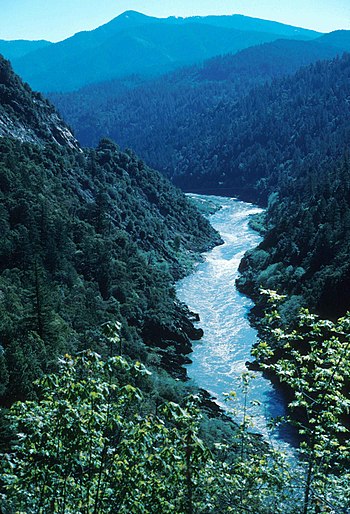Klamath River
The Klamath River flows 257 miles[1] through Oregon and northern California in the United States, emptying into the Pacific Ocean. The river has several dams, four of which are slated for removal in 2023 and 2024[2] in a rare public moment of agreement among government agencies, Native American tribes, and the wider population. This marks one of largest dam removal projects in world history.[3] Although everyone hopes that removing the dams will allow the decimated population of Chinook Salmon to recover, the restoration of flow may in fact come too late to save the fish.[4] Furthermore, removal of too much of its waters upstream, mainly for agriculture, remains a threat to the river's recovery environmentally and is a harder problem to solve politically.
By average discharge, the Klamath is the second largest river in California after the Sacramento River. It drains an extensive watershed of almost 16000 sq. miles, called the Klamath Basin, that stretches from the arid country of south-central Oregon to the temperate rainforest of the Pacific coast. Unlike most rivers, the Klamath begins in the high desert and flows toward the mountains – carving its way through the rugged Cascade Range and Klamath Mountains before reaching the sea. The upper basin, today used for farming and ranching, once contained vast freshwater marshes that provided habitat for abundant wildlife, including millions of migratory birds. Most of the lower basin remains wild, with much of it designated wilderness. The watershed is known for this peculiar geography, and the Klamath has been called "a river upside down" by National Geographic magazine.[5]
The Klamath is the most important North American river south of the Columbia River for anadromous fish migration.[6] Its salmon, steelhead and rainbow trout have adapted to unusually high water temperatures and acidity levels relative to other rivers in the Pacific Northwest. The numerous fish are a major source of food for Native Americans, who have inhabited the basin for at least 7,000 years. The first Europeans to enter the Klamath River basin were fur trappers for the Hudson's Bay Company in the 1820s; they established the Siskiyou Trail along the Klamath and Trinity rivers into the Sacramento Valley. Within several decades of European settlement, native peoples were forced into reservations. During the latter days of the California Gold Rush, increasing numbers of miners began working the Klamath River and its tributaries, causing considerable harm to the environment. Conflict and introduced diseases decimated indigenous tribes, reducing them to only 10% of their original population.
Steamboats operated briefly on the large lakes of the upper basin, contributing to the growth of towns such as Klamath Falls, Oregon, before they were replaced by railroads in the late 19th century. In the 19th and 20th centuries, the upper basin became a productive agricultural region, and many dams were built to provide irrigation and hydroelectricity. In the 1960s, the Klamath River was targeted by much larger but ultimately unsuccessful schemes to augment water supplies in other parts of California. One of these projects, the Klamath Diversion, would have reversed the entire flow of the Klamath River to supply farms and urban areas in central and southern California.
The Klamath is a popular recreational river and an important source of water for agriculture. It includes many of the longest free-flowing stretches of river in California, including excellent stretches of whitewater. However, dams and diversions in the upper basin have often caused water quality issues in the lower half of the river. Environmental groups and native tribes have proposed broad changes to water use in the Klamath Basin, including the removal of some dams on the river to expand fish habitat. They put forth their concerns in what is now the Klamath Basin Restoration Agreement, a water management plan signed by local communities, governments, tribal groups, environmentalists, and fishermen. The proposal has been endorsed by the U.S. Department of the Interior but has not been authorized by the United States Congress. In 2019, the Yurok tribe declared personhood for the Klamath River.
Provenance
- Some content on this page may previously have appeared on Wikipedia.
Notes
- ↑ National Hydrography Dataset via National Map Viewer. U.S. Geological Survey.
- ↑ Klamath River Dam Removal by Reis Thebault, Alice Li and Melina Mara in the Washington Post, Dec. 24, 2023. The authors wrote: "The largest-ever dam removal is underway, a milestone in the nation’s reckoning over its past attempts to bend nature to human will."
- ↑ 6 Things You Need To Know About The Klamath River Dam Removals by Marcus Kahn on the AmericanRivers.org website, June 23, 2023. Last access 12/18/2023
- ↑ On the Klamath, Dam Removal May Come Too Late to Save the Salmon by Jacques Leslie in YaleEnvironment360 published at the Yale School of the Environment, September 28, 2021.
- ↑ Rymer, Russ. "Reuniting a River: After fighting for years over its water, farmers, indigenous peoples and fishermen are joining forces to let the troubled Klamath River run wild again". National Geographic (December 2008).
- ↑ Yardley, William. Tea Party Blocks Pact to Restore a West Coast River, July 18, 2012.
